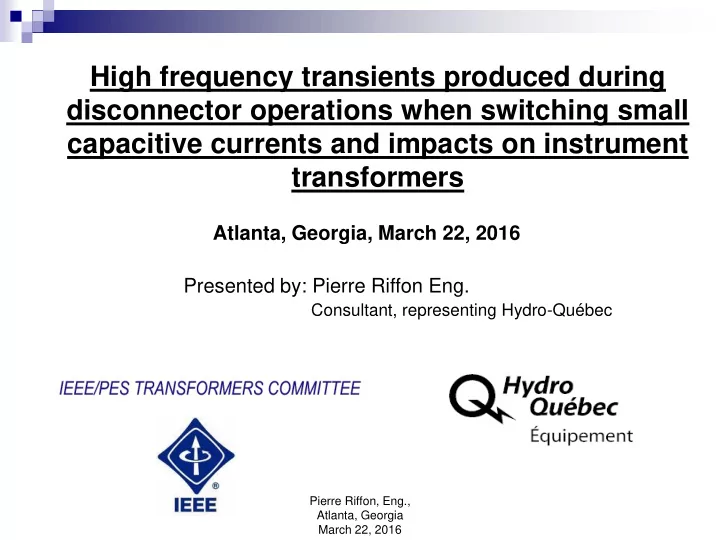

High frequency transients produced during disconnector operations when switching small capacitive currents and impacts on instrument transformers Atlanta, Georgia, March 22, 2016 Presented by: Pierre Riffon Eng. Consultant, representing Hydro-Québec Pierre Riffon, Eng., Atlanta, Georgia March 22, 2016
Sources of high-frequency switching transients within a substation Circuit-breaker operations: number of transients limited to one or few if re-ignitions or restrikes; Disconnector operations; large number of transient events, consecutive restrikes Pierre Riffon, Eng., Atlanta, Georgia March 22, 2016
Definition Disconnectors: a mechanical switching device which provides, in the open position, an isolating distance in accordance with specified requirements Note – A disconnector is capable of opening and closing a circuit when either negligible current is broken or made , or when no significant change in the voltage across the terminals of each of the poles of the disconnector occurs. It is also capable of carrying currents under normal circuit conditions and carrying for a specified time currents under abnormal conditions such as those of short circuit. Pierre Riffon, Eng., Atlanta, Georgia March 22, 2016
Definition (continued) Negligible current" implies currents such as the capacitive currents of bushings, busbars, connections, very short lengths of cable, currents of permanently connected grading impedances of circuit-breakers and currents of voltage transformers and dividers (see also IEC 62271- 305). For rated voltages of 420 kV and below, a current not exceeding 0,5 A is a negligible current for the purpose of this definition; for rated voltage above 420 kV and currents exceeding 0,5 A, the manufacturer should be consulted. "No significant change in voltage" refers to such applications as the by-passing of induction voltage regulators or circuit- breakers and bus transfer. Pierre Riffon, Eng., Atlanta, Georgia March 22, 2016
Disconnector operation In all cases, disconnector operations on an energized system always involve a certain capacitive current to be made or broken (capacitive current resulting from the stray capacitances of the load to be switched). • For Un ≤ 420 kV: I capactive ≤ 0,5 A; • For Un 420 kV: I capactive: Not specifically defined (Hydro-Québec specifies 1 A r.m.s. for 800 kV disconnectors) Pierre Riffon, Eng., Atlanta, Georgia March 22, 2016
System case Pierre Riffon, Eng., Atlanta, Georgia March 22, 2016
Equivalent single-phase circuit and test circuit Pierre Riffon, Eng., Atlanta, Georgia March 22, 2016
Tests performed Making and breaking tests on a 800 kV air-break disconnector; Applied voltage: 800 kV/√ 3 r.m.s, 60 Hz; Test current 1A Pierre Riffon, Eng., Atlanta, Georgia March 22, 2016
Typical making operation Pierre Riffon, Eng., Atlanta, Georgia March 22, 2016
Typical oscillogram during making Pierre Riffon, Eng., Atlanta, Georgia March 22, 2016
Typical oscillogram during making (zoom) Pierre Riffon, Eng., Atlanta, Georgia March 22, 2016
Typical breaking operation Pierre Riffon, Eng., Atlanta, Georgia March 22, 2016
Typical oscillogram during breaking Pierre Riffon, Eng., Atlanta, Georgia March 22, 2016
Typical oscillogram during breaking (zoom) Pierre Riffon, Eng., Atlanta, Georgia March 22, 2016
Typical oscillogram during breaking Pierre Riffon, Eng., Atlanta, Georgia March 22, 2016
Typical oscillogram during breaking (zoom) Pierre Riffon, Eng., Atlanta, Georgia March 22, 2016
Stresses observed Load side: Repetitive reversal impulses ( one per half cycle ) reaching the surge protective level of the protective arrester; Repetitive high-frequency current impulses ( one per half cycle ); Frequency of the high-frequency current seen during tests: 85 kHz (depending of the loop inductance between the source side capacitance and the load side capacitance); This repetitive stress may last for few seconds e.g. 120 impulses/second; Typical values obtained for a 800 kV disconnector: Peak voltage: 1380 kV (66% of the rated BIL), time to peak 6.0 µs, dV/dt 230 kV/µs; Pierre Riffon, Eng., Atlanta, Georgia March 22, 2016
Stresses observed (continued) Load side (continued): Stress extremely harmful for the instrument transformer located on the switched bus; A special test (600 chopped-waves test) is specified by IEC and IEEE C57.13.5 to cover this type of switching event. Pierre Riffon, Eng., Atlanta, Georgia March 22, 2016
Stresses observed (continued) Source side: Repetitive high-frequency current impulses ( one per half cycle ); Repetitive high-frequency oscillation on the source side voltage; No significant overvoltages (1.5 p.u.); This repetitive stress may last for few seconds e.g. 120 current impulses/second; Frequency of the high-frequency oscillation and impulse current seen during test: 85 kHz (depending of the loop inductance between the source side capacitance and the load side capacitance); Pierre Riffon, Eng., Atlanta, Georgia March 22, 2016
Stresses observed (continued) Source side (continued): As for instrument transformers, this stress can be extremely harmful to the transformer bushings (generally having the same type of insulation system as instrument transformers). Could be also harmful to the transformer winding insulation if the high-frequency oscillation hit an internal transformer winding internal resonance. Pierre Riffon, Eng., Atlanta, Georgia March 22, 2016
Recommend
More recommend